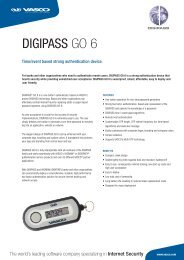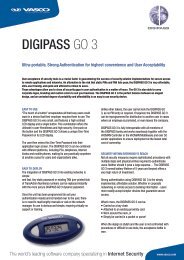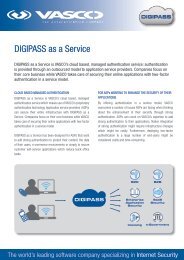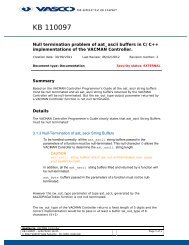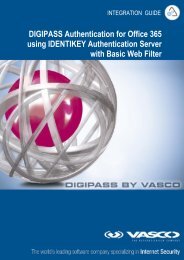Digipass Plug-In for SBR Administrator Reference - Vasco
Digipass Plug-In for SBR Administrator Reference - Vasco
Digipass Plug-In for SBR Administrator Reference - Vasco
You also want an ePaper? Increase the reach of your titles
YUMPU automatically turns print PDFs into web optimized ePapers that Google loves.
<strong>Digipass</strong> <strong>Plug</strong>-<strong>In</strong> <strong>for</strong> <strong>SBR</strong> <strong>Administrator</strong> <strong>Reference</strong> ODBC Database<br />
3.6.2 Access to Another Schema<br />
Depending on the database type, there may be a problem with one database user account<br />
accessing the tables from another schema/user account. <strong>Digipass</strong> <strong>Plug</strong>-<strong>In</strong> <strong>for</strong> <strong>SBR</strong> components<br />
will access the tables according to the table names that are defined in the vdsControl table.<br />
If the tables are not accessible to the database user account without qualifying the table name<br />
(eg. schema.table), there are a few ways to solve the problem:<br />
Set the default schema or database. Some databases allow you to specify which<br />
schema or database a database user account will use by default when they log in. This<br />
may be a setting in the database itself or the ODBC data source<br />
Create views. You can create a view <strong>for</strong> each table in the database user account's own<br />
schema, that provides access to the table. The view names should match the table<br />
names. However, be careful that your database type permits the necessary INSERT,<br />
UPDATE and DELETE operations on the views (see the table above). Some database<br />
types provide only limited support <strong>for</strong> those operations or disallow them all.<br />
Modify the vdsControl table. Provided that all database user accounts need the<br />
schema qualifier in front of the table names, you can safely modify the vdsControl table<br />
entries to add the schema qualifier (see below).<br />
Another possible solution is to create a vdsControl table in each database user account's<br />
schema, that contains the necessary schema qualifier. However this is not recommended, as it<br />
is complex to set up and there are other settings in the vdsControl table other than the table<br />
names. It would be easy to end up with different settings in each table.<br />
3.6.2.1 Modify vdsControl Table<br />
There are two parts to this solution. Firstly, to make sure that the vdsControl table itself can<br />
be accessed; secondly, to update the remaining table names using the vdsControl table.<br />
The <strong>SBR</strong> <strong>Plug</strong>-<strong>In</strong> component uses a configuration setting in its configuration file<br />
dpsbrauth.xml to identify the vdsControl table name:<br />
VASCO->AAL3->ODBC->Data-Sources->Data-Sourcesnn->Control-Table<br />
where nn is 01 <strong>for</strong> the first data source, 02 <strong>for</strong> the next, and so on. Each data source must be<br />
configured separately.<br />
However, the administration interface does not use this configuration file, and if the<br />
administrator database account has a schema qualifier problem <strong>for</strong> the vdsControl table,<br />
another solution such as a view must be used.<br />
Modification of the vdsControl table entries that define the table names must be per<strong>for</strong>med<br />
using your database's SQL utility. The following entries in vdsControl are used to define the<br />
table names:<br />
Table 23: Table Names in vdsControl<br />
© 2006 VASCO Data Security <strong>In</strong>c. 52




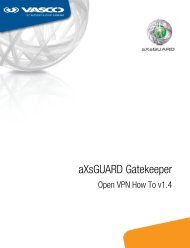
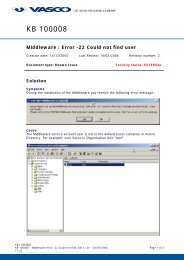
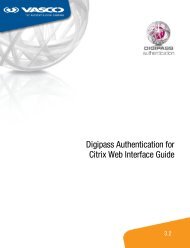
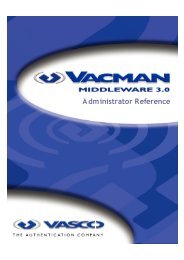
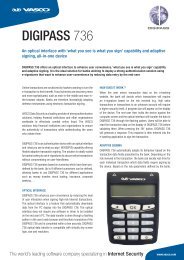
![KB [100006] - Vasco](https://img.yumpu.com/12539350/1/184x260/kb-100006-vasco.jpg?quality=85)

